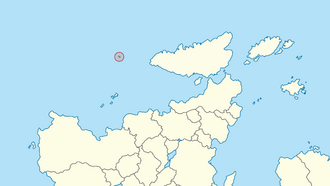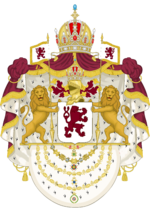Aurora Islands
Crownland of the Aurora Islands | |
|---|---|
Crownland of the Weranian Confederation | |
|
| |
| Motto(s): Tääbbin mij láá jeđe teehi mij pääccip (Auroran Annic) "Here we are, and so here we shall remain" In Treue fest (Weranian) Oskolâšvuođâst nanos (Auroran Annic) "Steadfast in loyalty" | |
| Anthem: "Was ist des Ostischen Vaterland?" "What is the Weranic’s fatherland?" | |
| Regional anthem: "Suolluin" "On the islands" | |
 Location of the Aurora Islands (circled in red) in Northern Euclea | |
| Country | Weranian Confederation |
| Weber Purchase | 14 May 1682 |
| Capital | Niedkirch |
| Official languages | Auroran Annic, Weranian |
| Religion | Solarian Catholicism |
| Demonym(s) | Aurora Islander (Official) Auroran |
| Government | Parliamentary constitutional monarchy |
• Monarch | Charlotte II |
| Otto von Hößlin | |
• Premier | Geažotmiella Gápepärni |
| Legislature | Eenâkodde/Landtag |
| Area | |
• Total | 2,183 km2 (843 sq mi) |
| Population | |
• 2018 estimate | 132,854 |
• Density | 60.5/km2 (156.7/sq mi) |
| GDP (PPP) | 2018 estimate |
• Total | $4.9 billion |
• Per capita | $37,230 |
| GDP (nominal) | 2018 estimate |
• Total | $5.1 billion |
• Per capita | $38,190 |
| HDI | 0.965 very high |
| Currency | Euclo (€) (EUC) |
| Date format | dd/mm/yyyy |
| Driving side | left |
| Calling code | +425 |
| Internet TLD | .ai |
The Aurora Islands (Auroran Annic: Kuovskâssuolluuh [ˈkuo̯vːskɐˌsːuo̯lːuːh]; Weranian: Nordlichterinseln [ˈnɔːtlɪçtɐʁˌɪnzl̩n]), officially the Crownland of the Aurora Islands (Auroran Annic: Kuovskâssuollui ruvnâeennâm, Weranian: Kronland der Nordlichterinseln) is an archipelago and a self-governing crownland of the Weranian Confederation located in the Avanaric Sea. The total area of the islands is around 2,183 square kilometres, and its population is estimated to be 132,800. The capital and the largest city of the Aurora Islands is Niedkirch.
Prior to settlement, the Aurora Islands were used sporadically as a fishing and whaling spot by Ejderic fishermen. The islands were initially settled by Ejderic people who brought with them Annic thralls, wives and labourers in 705 CE. The onset of the Marauder Age from the 9th century onwards saw the arrival of Sotirian missionaries and an increasing number of displaced Annic people fleeing Ghaillish conquest and raiding resutling in the Annic population overtaking the original Ejderic settlers. The Aurora Islands were subject to intermittent raiding and Sotirianisation throughout the Middle Ages. By the late 10th century, the islands were almost fully Sotirian. Weranic merhcants began trading with the islands in significant amounts from 1321 onwards. This led to the establishment of a mercnatile political order and the formation of the Landtag in 1443.
The Weber Family sold the Aurora Islands to the House of Kotzauberg on 14th of May 1682 which created a personal union between the Aurora Islands and the Kingdom of Roetenberg. The islands retained a high degree of self-rule in the union. Following Weranian Unification in the mid 1800s, the relationship between the islands and Werania was reformed where the Aurora Islands were designated a crownland of Werania in 1872. The antebellum period before the Great War saw internal political instability in the country in the form of protests. Ultimately, agreement was reached where universal suffrage would be passed in order to avoid conflict. The Aurora Islands had historically been an agrarian nation with an economy based on fishing until the late 1950s. The Weranian entry into the Euclean Community in 1955 resulted in a long period of sustained economic growth as Euclean companies moved into the islands to take advantage of loose tax laws making it into an offshore financial centre.
Today the Aurora Islands is a self-governing dependent territory of Werania. Its government is a democratic parliamentary constitutional monarchy that is in a personal union with the Grand Duchy of Roetenberg through the House of Kotzauberg. Following the ascension of Charlotte II to the Weranian Federal Presidency in 1987, this union has extended to the confederation as a whole. The islands are composed of X municipalities the largest of which is Niedkirch, the country's capital where over a third of the population lives. It posesses a developed high-income economy the largest sectors of which are fishing and finance.
Etymology
The Ejderic name Norðskíneyjar meaning "Northern light islands" has been found on two rune stones. This name was given to it by the first Ejderic settlers of the island who named the islands based off the northern lights (Aurora borealis), a natural phenomenon that occurs frequently from late August to early April on the islands. The Solarianisation of the name, Insulae Aurorae, became widely used from the 10th century onwards. Historically the islands were also known as the "Far Aurores" (Weranian: Fernauroren/Fernlichterinseln). However, in 1881 the name "Aurora Islands" (Auroran Annic: Kuovskâssuolluuh, Weranian: Nordlichterinseln) was officially adopted.
History
Settlement and early history
According to the Alþyðubók, a list of records detailing the inhabitants of the Aurora Islands compiled between 792 and 812 CE, the first settlers of the islands arrived in 736 CE. They were primarily Ejderic people with a minority of Annic people also mentioned in the records largely as thralls, wives and labourers. The settlers introduced several species intentionally to the islands such as the mink and hare, while others such as the house mouse were introduced unintentionally. The economy of the Aurora Islands was based largely around fishing and around farming to a lesser extent. The islands relied on trade with Northern Euclea.
Early Auroran society was headed by a chieftain referred to as a "Hersir" who was in charge of the military defence of the islands. This title was ever held by three people in the Aurora Islands: Arne of Stórrstaðr (739-755), Halfgal Arnesson (755-761) and Ráfi the Maiden (761-804). The Hersirs of the Aurora Islands bore alligience to the king of Staðhafi. Besides a leader in the form of the Hersir, early Auroran society had a distinctive lack of political authority. Most disputes were solved on an individual or family basis. Sometimes disputes between families developed into generations-long bloodfeuds. Following the death of Ráfi the Maiden in 804 CE, a four-month-long conflict broke out known as the Blood Months which left the islands without a claimant for the title.
Marauder Age

Prior to the first raids, trade between the islands and Northern Euclea had increased significantly. This increase in trade is often credited with bringing more attention to the Aurora Islands resulting in Ghaillish raids, Sotirian missionaries and Annic people arriving on the islands. Raids conducted by Ghaillish pirates happened sporatically throughout the Marauder Age in the Aurora Islands. Due to the small population of the islands, the raids were often devastating both economically and societally. Despite evidence of heavy violent resistance on the part of the islanders, most raids to the islands were successful culminating in the burning of Ausmanna, the islands' largest settlement, in 993 CE. The islands managed to only stave off a raid towards the end of the Marauder Age in 1053 CE. In 924 CE, a Sotirian mission was carried out by Geatish Priest Folkquinus to the Aurora Islands with the intent of converting the pagan population. Eventually the mission established the presence of the Solarian Catholic Church on the islands. The Solarian Church would rise to become the central pillar of Auroran society towards the end of this period. The fast spread of Sotirianity in the islands is often believed to have been caused by the economic and societal uncertainty that resulted from raids and the lack of any pre-existing central political authority.
The Aurora islands experienced a demographic change during the Marauder Age; the islands had always had a small population of Annic people. However, this period of time saw the Annic population overtake the original Ejderic population as the dominant group on the islands. This happened primarily through steady Annic immigration into the islands between the 800s and 900s CE. The exact reason behind this movement of people remains contested between historians. In Annic folklore, the Aurora Islands were the place of origin of the Stallo which has been taken as evidence that Annic people had known of the islands for a long time, yet evidence of contact between the islands and the Annic homeland before the late 700s CE has not been found. It is suggested that the immigrating Annic people were fleeing from the marauders, however evidence of marauder raids, especially devastating ones, in the Annic homeland is sparce. What is most commonly accepted is that Marauder raids coupled with the violent clashes they often caused led to a population decrease in the islands especially that of its male Ejderic population and the diminution of the Annic homeland contributed to one group exceeding the other without internal conflict.




